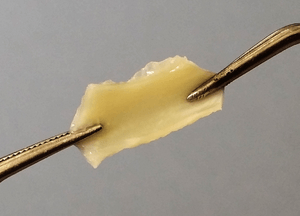Elastin facts for kids
Elastin is a special protein in your body. It's like a super stretchy rubber band! It helps many parts of your body stretch and then snap back to their original shape. Think about your skin: when you pinch it, it quickly goes back to normal. That's thanks to elastin.
Contents
What is Elastin?
Elastin is a key part of your connective tissue. Connective tissue is like the "glue" that holds your body together. Elastin is a type of protein that is very elastic. This means it can stretch a lot without breaking. After stretching, it can return to its first shape. This ability is super important for how your body moves and works.
How Elastin Works
Elastin helps your body store and release mechanical energy. Imagine a spring: you can push it down, and it bounces back up. Elastin works in a similar way. It allows tissues to stretch when needed, then recoil and go back to their normal size. This is vital for many body functions.
Where is Elastin Found?
Elastin is found in many places in your body where things need to stretch.
- Blood Vessels: It's very important in blood vessels, especially large ones like the aorta. The aorta is the main artery that carries blood from your heart. Elastin helps these vessels expand and contract with each heartbeat. This keeps blood flowing smoothly.
- Lungs: Your lungs need to stretch and shrink as you breathe in and out. Elastin helps them do this easily.
- Skin: Elastin helps your skin stay firm and bounce back. It's why young skin looks smooth and returns to shape quickly.
- Other Body Parts: You can also find elastin in your ligaments (which connect bones), your bladder (which stretches to hold urine), and in elastic cartilage (a flexible tissue).
Elastin Across Animals
Elastin is found in all vertebrates. This means all animals with a backbone have it. This includes fish, birds, reptiles, and mammals, like humans. Even very old types of fish, except for the earliest jawless fish, have elastin.
Elastin in Humans
In humans, the instructions for making elastin are stored in a special part of our genes. This specific gene is called ELN. It tells our bodies how to build this important stretchy protein.
Images for kids
See also
 In Spanish: Elastina para niños
In Spanish: Elastina para niños


